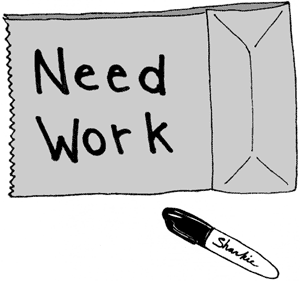![]()
contributed by James LeDoux [IT training consultant / travel enthusiast / dancing machine]
EDITOR’S NOTE: Last month, James LeDoux, our whiz kid biz contributor, shared the vital must-haves of any résumé, revealed some corporate candidate search secrets,  and spelled out the mistakes that could cost you that first all-so-important interview. Now James expands upon the topic to include the modern, digital world. And if you think prepping your résumé for cyberspace is exactly the same as for office space, think again. Posting online involves its own set of dos and don’ts, so read on and let technology work its magic for you.
and spelled out the mistakes that could cost you that first all-so-important interview. Now James expands upon the topic to include the modern, digital world. And if you think prepping your résumé for cyberspace is exactly the same as for office space, think again. Posting online involves its own set of dos and don’ts, so read on and let technology work its magic for you.
Online Résumés
The success of websites such as Monster.com, Dice.com, TalentZoo.com, and Yahoo!’s Hotjobs.com indicate that employers and recruiters like these services. Any successful résumé writer would be remiss if they did not use these sites to their full advantage.
The sites allow you to search job listings quickly and, more importantly, post your résumé. Posting online will lead to contacts by prospective employers. It will also likely lead to many contacts for jobs you have no interest in or even qualifications for.  Be prepared to receive emails and calls for many jobs that make you wonder if the recruiter actually read your résumé before calling or sending you a note. Depending on the criticality of your job search and how often this happens, it can be frustrating. Don’t let it be. The person on the other end is probably under just as much pressure to find someone as you are to find a job.
Be prepared to receive emails and calls for many jobs that make you wonder if the recruiter actually read your résumé before calling or sending you a note. Depending on the criticality of your job search and how often this happens, it can be frustrating. Don’t let it be. The person on the other end is probably under just as much pressure to find someone as you are to find a job.
Keys For Success With Online Résumés
- Limit your contact information to an amount with which you are comfortable. You can often let employers view just your résumé with no contact information. I personally don’t mind getting called because the IT contract postings I seek get posted and filled very quickly.
- Follow up on each email or call that you receive. It is good form to respond to each and every contact. Though the initial job they offer may not fit, you may be surprised that a recruiter or HR rep will contact you later with other listings.
- Share the Love. If you find a job that doesn’t fit your interests, share the listing with a friend or classmate. They will be appreciative and will likely return the favor. Just be sure to avoid stacking the odds against yourself by encouraging direct competition for a job you really want. Wait until you secure the job and then let your peers know if the firm is seeking other applications.
- Use HTML formatting, when it is offered, to spice up your résumé. Online résumés are mostly text; however, many sites let you use HTML coding* to format the text. A little extra time here can pay off big in terms of the look and feel of your online résumé.
- Keep it current. Employers scan online résumés by the criteria they are seeking. One key piece of information is the date of the last update. Newer résumés show up before older ones. Thus, updating your résumé slightly from time to time will make sure it stays near the top.
*The key to using HTML tags on your online resume is to keep them simple. Read: no blinky lights and garish colors. Avoid getting too carried away and creating something that distracts from your now compelling resume. The tags I recommend are:
|
HTML Tag |
Purpose |
Code Example |
|
Bold |
Use bold to highlight titles or as headings to sections |
<b> content to bold </b> |
|
Bulleted lists |
Use bullets to replicate your format |
<ul> <li> list item 1</li> <li> list item 2 </li> <li> list item 3 </> </ul” |
|
Links |
Use links (sparingly) to connect to online portfolios or work projects that showcase your talent
Note: Be sure to test links periodically to make sure they are still working.
|
<a href="https://plinthandchintz.com"> Plinth and Chintz</a>
|
|
Breaks and Paragraphs |
Use breaks and paragraphs to create white space to ease online reading |
<br> for a line break
<p> for a paragraph break
|
To learn how to use these tags properly consult the NCSA HTML Primer or any basic HTML book.
Also consider using Word’s “Save as HTML” option to create an HTML version of your resume. You can then copy and paste the HTML code to the online resume and view the results.
Since they are all slightly different, be sure to test out the results on all major web browsers (Internet Explorer, Mac Safari, and Mozilla’s Firefox, etc.) and make sure that you are happy with the results. If you get really stuck, just trade some of your newfound resume tips for help having someone fix any technical issue that you can’t handle.
Start a Farm
Many people make the mistake of creating a résumé only when they need to find a job. Should some unfortunate incident happen and you need to find a job quickly, you have already handicapped yourself.  Well-crafted résumés take time, and I highly recommend starting your own little farm — a résumé farm that is.
Well-crafted résumés take time, and I highly recommend starting your own little farm — a résumé farm that is.
“Résumé farm” is my pet term for a collection of résumés. As mentioned above, customizing your résumé to each job application is the best way to increase your chances of getting a face-to-face interview. Why not keep a copy of each of those versions in case you later apply for a similar job” Thus, the résumé farm is born. My résumé farm currently resides online in my Yahoo! folders. This way, it is easily accessed from anywhere I need it. I also keep a backup on my hard drive and offline on a data CD. Here is one way you can organize your farm:
Résumé Farm File Structure
- Archive — old but potentially useful résumés
- Current — active résumés
- Templates — templates
- Notes — general files related to résumé writing, employment history, reference information, etc.
- Tracker — holds my Excel tracker file for all job searches; for each job listing I include the job description, résumé version submitted, contact info, and next follow-up action / date
Like a real farm, the key here is to tend to it periodically. I would encourage you to make a habit of updating your résumé on a quarterly basis. Though you may not be looking for a job, this simple act will keep you primed and focused through the year. It also ensures that you track toward any short- or long-term goals on your professional development plan. Come review time, this type of effort will show in your work.
Last But Not Least
Finding the “ideal” job requires first, that you know what you want, and second, that you have the patience, perseverance, and drive to go get it. Think of your résumé as a work in progress and something that will grow and develop over time. As your goals, skills, and style change, so will your résumé.
And finally, if you take nothing else away from this article… hit the spell-check button one last time before you send or print your next résumé. What good does the last four years of hard work do if you let a little fat-finger typo get your résumé filed in the recycle bin”!”
Now go out there and get hired!
Resources
Resume Help – free online resource with great examples and tips
Monster – free online job search and résumé posting that now offers résumé-writing service
Dice – free online job search and posting that’s a good place to scan for job descriptions and key buzz words
TalentZoo – free job search and résumé posting with lots of ad, design, and related fields posted here
Job Search Help from Answers.com – free online resource
JobSpin.com – Has a vertical search engine that gives job seekers free access to millions of employment opportunities from hundreds of Web sites.
The Resume Handbook: How to Write Outstanding Resumes & Cover Letters for Every Situation (Resume Handbook) – an easy to follow book by Arthur D. Rosenberg, David V. Hizer that’s very affordable
101 Best Resumes: Endorsed by the Professional Association of Resume Writers – who knew that there was an Association of Résumé Writers”; contains very good examples and can be used as an excellent reference; also very affordable


